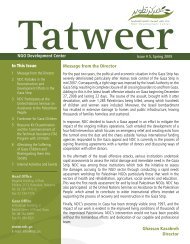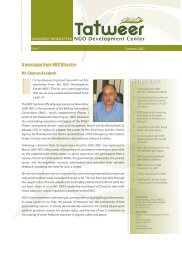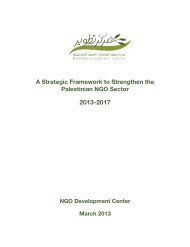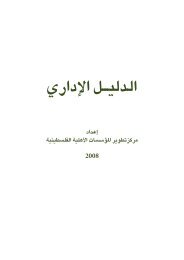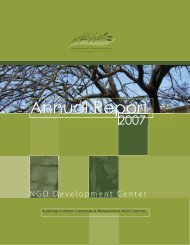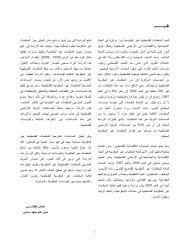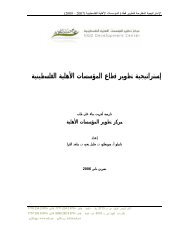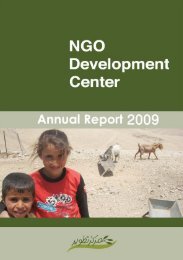Tracking External Donor Funding.pdf - NDC
Tracking External Donor Funding.pdf - NDC
Tracking External Donor Funding.pdf - NDC
Create successful ePaper yourself
Turn your PDF publications into a flip-book with our unique Google optimized e-Paper software.
Due to the fact that the donors sampled each had a<br />
number of PNGO partners, ranging from 2 to 25, the<br />
survey of 41 donor institutions may have yielded a<br />
sample of as many as 800 PNGOs, much higher than our<br />
PNGO survey sample of 80 organizations. Like our<br />
donor survey, the survey of PNGOs was an opportunity<br />
to look more closely at the activities of the other side of<br />
the equation. Because PNGOs, especially larger ones,<br />
have a number of donors ranging anywhere from 1 to 20<br />
according to our data, the PNGOs survey have returned a<br />
donor sample in the hundreds (around 540), allowing us<br />
to look more closely at the trend in external funding in<br />
terms of the source and type of aid, as well as the level of<br />
aid dependency experienced by PNGOs.<br />
Figure1: <strong>Donor</strong> – PNGO Survey Rationale<br />
Don<br />
Don<br />
Don<br />
Don<br />
PNG PNG PNG PNG<br />
<strong>Donor</strong> Survey 2<br />
Our donor survey aims to track external aid into the<br />
PNGO sector over a ten year period according to the<br />
sector, geography and target population of its<br />
distribution. <strong>Donor</strong> Survey fieldwork was conducted<br />
between April and July of 2009.<br />
Sample and Approach<br />
A total 41 institutions were surveyed directly and each<br />
returned completed data for at least one year. <strong>Donor</strong>s<br />
were chosen primarily on a basis of perceived scale, the<br />
findings of previous MAS studies and through<br />
consultations with stakeholders. As our study sought to<br />
cover a specific percentage of funding to PNGOs in<br />
2008, projects and programs from any available source<br />
were compiled indirectly in order to help meet that goal 3 .<br />
Indirect data gathering included the use of the websites<br />
and financial reports of organizations.<br />
Efforts were also made to differentiate our sample along<br />
other lines, such as the type, the region of the aid's<br />
origin, the sector of the donor's work and their estimated<br />
contributions to the PNGO sector. Especially in the case<br />
of INGOs, only those who utilized the majority of their<br />
funding in direct partnerships with PNGOs were<br />
approached; while those INGOs who directly implement<br />
most of their own projects were not.<br />
The primary division within our sample is between<br />
Governmental (bi-lateral and multilateral aid) and<br />
Nongovernmental (INGO, Private and Religious)<br />
2<br />
3<br />
<strong>Donor</strong> questionnaire available in Appendix VI.<br />
We originally set out to reach 70% of the total external funding to<br />
PNGOs in 2006 according to previous MAS mappings of the<br />
PNGO sector. As the following section shows, we were able to<br />
capture much more than that in both of our surveys.<br />
sources. The 25 nongovernmental agencies surveyed<br />
provided up to 55% of the external aid captured in our<br />
survey, while the 16 governmental agencies provided the<br />
remaining 45%. Though it is largely true that INGOs act<br />
as intermediary channels of Government funding to<br />
PNGOs, we worked to analyze whether the behaviors of<br />
the two groups differed. In other words, are INGOs able<br />
to assert their own agendas, not necessarily those of the<br />
government financing them We also wanted to look at<br />
how the channels of funding to PNGOs are affected by<br />
political upheaval and whether governments prefer<br />
bilateral, multilateral or indirect (INGO) partnerships<br />
with PNGOS.<br />
The expansion of our donor sample beyond governments<br />
and into the INGO sector is crucial to capturing the real<br />
picture. The MoP, from the MoPIC system to the current<br />
PAMS database, has not been given the legal mandate to<br />
capture external aid to PNGOs channeled through<br />
INGOs. As Hanafi’s 1998 study for Welfare shows in the<br />
table 1, the failure to incorporate INGO funding into the<br />
picture dramatically underestimates the amount of<br />
external funding allocated to PNGOs. According to<br />
Hanafi’s findings, when INGOs funding to PNGOs is<br />
included, the amount of total external aid to the WB&GS<br />
captured by the PNGO sector moves from 11% to 18%.<br />
Table 2 shows the results of the donor survey against the<br />
official time series estimates of the MoP, as well as the<br />
two cross-sectional estimates of MAS in 1999 and 2006.<br />
The success of our survey fluctuated according to the<br />
year, as well as the estimate of total aid entering the<br />
PNGO sector. If the official estimates of the MoP are<br />
used, the survey managed to cover nearly 64% of the<br />
total estimated aid to PNGOs in 2008. However, if<br />
MAS’s 2006 estimate is assumed to be closer to reality,<br />
our survey managed to capture 76% of the external aid to<br />
PNGOs in 2006.<br />
2


